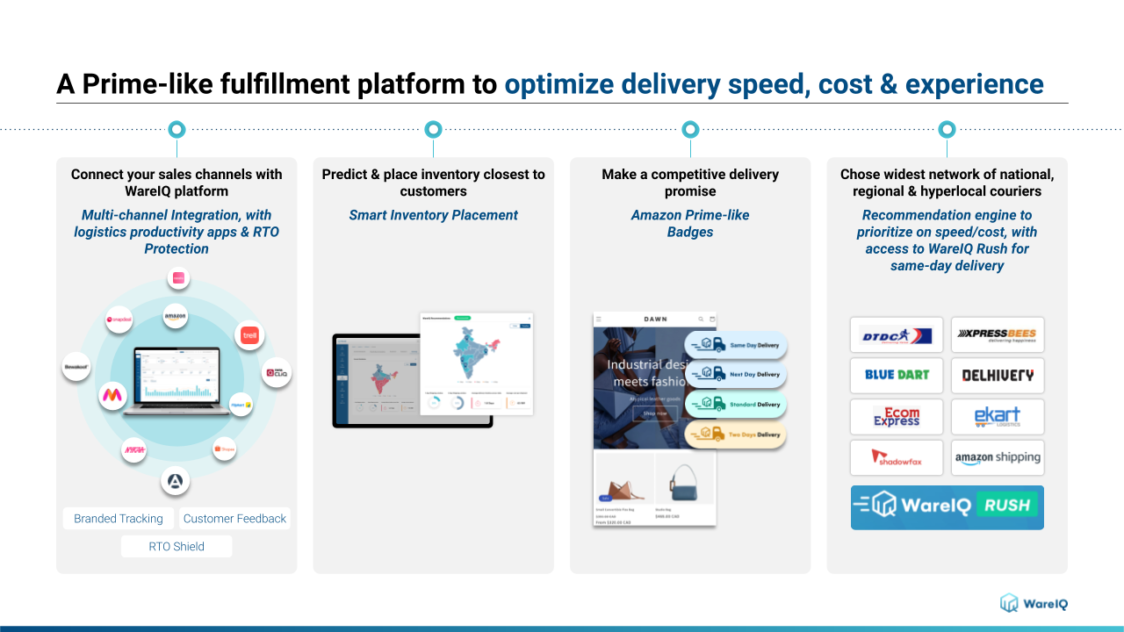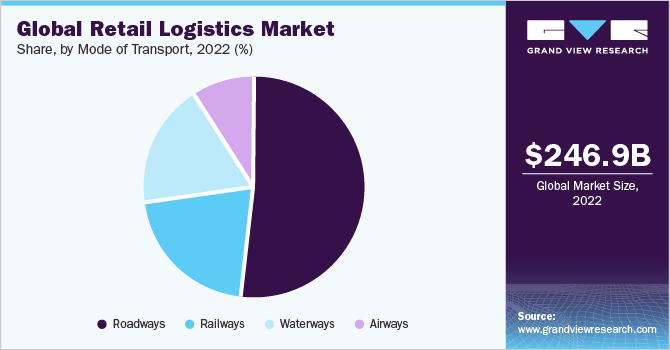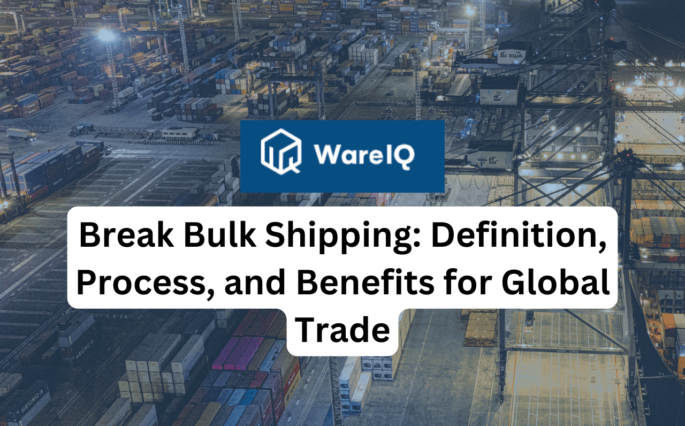Retail Logistics: Definition, Functions, Challenges and Methods to Improve Retail and Logistics Management in eCommerce in 2025

Buyers these days expect a quick and good experience with any brand. They expect customizable products with similar delivery options that use advanced automation of logistics processes. Technology has made this possible. Nowadays, there are many different products on the market and this calls for a planned strategy from the point of receiving an order to the point of delivery. By using effective retail logistics and added value, you can make sure that everything is in place to provide better delivery and service at reduced costs. In this blog, we will take a look at retail logistics, its advantages, and how retail and logistics management can be improved.
- What is Retail Logistics?
- 6 Functions of Retail Logistics in eCommerce
- Common Challenges in Retail Logistics in 2025
- Impact of Retail Logistics in eCommerce
- 3 Ways to Improve Your Retail and Logistics Management
- Conclusion: Enhance Your Retail Logistics With WareIQ
- Retail Logistics: Frequently Asked Questions (FAQs)
What is Retail Logistics?
Retail logistics is the systematic process of controlling the movement of goods from the point of supply to the buyer. By using effective retail and logistics management, you can make sure everything is set up to provide better delivery and service at reduced costs. The warehouse receiving, inventory management, fulfillment and shipping phases are parts of the retail logistics process.
In order to achieve customer expectations for quick, economical delivery, every step of the logistics process should be streamlined. This means that an efficient retail logistics operation frequently needs both manpower (warehouse personnel as well as upper-level management positions, such as a logistics director) and slick software solutions, which can dramatically raise logistics expenses.
WareIQ, an eCommerce fulfillment company, empowers online brands with a superior-tech platform to compete with Amazon like service levels by bringing their average delivery timelines from 5-10 days to 1-2 days.
6 Functions of Retail Logistics in eCommerce
Inventory Handling
To fulfill orders, your products must be received and processed from the supplier. Incoming eCommerce goods are unloaded and formally checked in, after which it is properly documented and stored. Receiving and processing inventory is crucial. It not only promotes effectiveness and expedites the fulfillment process but it also guarantees that what is received corresponds to what was purchased. A lack of clear protocols can easily result in loss, which has an effect on both your customers and your bottom line. Examples of such operations include unloading, receiving and allocating SKUs.
Inventory Distribution
Distributed inventory is a method of allocating inventory where stock is distributed among several warehouses or fulfillment locations as opposed to just one. This system’s basic premise is that it brings your goods closer to your clients, making it one of the best ways to speed up delivery times and lower transportation costs. The price of satisfying retail orders depends on delivery zones so thus, the closer a shipment is to the buyer, the less the retail logistics will cost them. An example would be an Uber ride, where distance corresponds with increasing costs.
Distributing inventory throughout many retail warehouses can help your business grow by enabling you to provide low-cost 2-day shipping which is a benefit that many customers have come to expect as a result of online retailers like Amazon. In an economy that depends on quick fulfillment.
Many rapidly expanding firms outsource fulfillment to a 3PL like WareIQ, which runs a vast network of fulfillment centers because they lack the time or resources to manage several warehouses.
Order Fulfillment
Don’t undervalue the importance of quick and economical delivery to customers. It is essential to have a strategy in place for cost-effective and efficient retail logistics. A variety of coordinated procedures begin as soon as your customer confirms their order, ensuring that their information is verified and the appropriate products are selected and packaged as soon as possible. The procedure is referred to as “order-to-cash” (O2C).
In order to complete the order and collect payments from the client, inventory management and accounting procedures must be completed within the O2C cycle. To track orders and save historical order data, which is later used to evaluate O2C performance, a healthy O2C cycle also needs an order management system. The order processing and fulfillment process can be automated if you work with a 3PL like WareIQ. Orders are routed from the closest fulfillment facility to the shipping destination once your online store is connected to WareIQ’s fulfillment platform.
Shipping
An order is dispatched as soon as it has been picked, packed and labelled. If your retail logistics network includes numerous warehouses, the shipment is transported from the one that is closest to the destination. eCommerce shipping entails setting up orders to be delivered to the customer in the most dependable, economical manner possible. Shipping incentives, such as free shipping and same-day and next-day delivery can effectively be employed as marketing strategies. You can leverage product bundles, provide minimum spending requirements, partner with 3PLs that handle shipping and offer negotiated bulk shipping rates and pass on the savings to your consumers to help cover the cost of shipping (including free delivery).
Product Tracking
It is important to have real-time retail logistics tracking in place across the whole eCommerce supply chain. Maintaining ideal inventory levels and determining when to replace inventory to fulfill demand without overstocking and raising holding costs can be difficult without real-time tracking of product levels. You can track orders and shipments using digital order tracking and you can also give your customers tracking details.
For example, using the WareIQ app that integrates with your choice of eCommerce platform, you can automatically send each customer a confirmation email and provide them with the tracking number and related details. You can view the order’s status in real-time as it goes through each stage, from processing to shipment and everything in between.
Returns Management
If not effectively handled, the returns management process can include additional receiving, packaging, evaluation, reprocessing and even replacements. Returns can be seen as a chance to improve the client experience even more. A fantastic method to improve the customer experience is to train your customer support employees to initiate returns while simultaneously soliciting client feedback. Overall, implementing retail logistics solutions that speed up returns can significantly affect the expansion of your organization.
Common Challenges in Retail Logistics in 2025
Rising Consumer Expectations
The conveniences that the modern customer has grown accustomed to, particularly when it comes to shipping, have a direct impact on their shopping decisions. According to National Retail Federation research, 3/4ths of consumers want delivery to be free but in another survey, 77% of consumers showed that they are willing to pay more for next-day or same-day delivery.
Two-day shipping was originally offered by eCommerce giant Amazon more than 15 years ago and it swiftly became the norm. Since then, Amazon has narrowed the time frame for its deliveries, obliging all other sellers to do the same.
Lack of Inventory Visibility
Even the most effective retail fulfillment strategy can be hampered by a lack of inventory visibility, both in terms of the overall number of SKUs and where inventory is situated. Fortunately, this problem with retail logistics has two rather simple remedies:
- First, companies must keep an eye on inventory numbers. There are a variety of measures you may use to obtain visibility into your inventory, including inventory carrying costs, successful order percentages, percentages of orders filled from ideal inventory locations and inventory turnover rates. For the best return on investment (ROI), make sure that any metrics or key performance indicators (KPIs) you track are in line with the strategic, financial and customer goals of your business.
- Second, create a WMS-based retail fulfillment process that is effective. WMS technology has many advantages, such as improved workflow and process design, interaction with purchase order systems and tracking SKU levels at the lot, and much more. It can even enable inventory metrics through KPI generation and customized reporting.
To provide your customers with seamless omnichannel experiences and want to attain inventory visibility, you can use it as an accurate forecast of future demand and manage your supply-chain activities accordingly.
Complex Disruptions in the Supply Chain
Global and local supply chains are very complex. While expanding retail logistics operations across the country has helped many businesses cut expenses, diversify their product lines, increase production efficiency and more, it has also increased the danger of supply chain interruptions, caused due to a variety of factors such as manufacturing issues, transport issues, unforeseen delays and much more.
Impact of Retail Logistics in eCommerce
In changing times a lot of changes have been seen in eCommerce due to Retail Logistics. A few of them are:
Growth of Mobile Commerce
It comes as no surprise that there has been a considerable shift to mobile commerce given the broad adoption of smartphones. More people are now purchasing online due to the temporary closure of brick and mortar stores worldwide to stop the spread of COVID-19 and the avoidance of those stores by many customers who chose to adopt social distancing. EMarketer reports that 43% of online retailers experienced an increase in sales during the pandemic. Electronics, home goods and office supplies, which boost comfort and allow individuals to achieve more while at home, saw a dramatic increase in demand, whilst non-essentials like jewellery and consulting services saw a decline in demand as consumers decreased spending on non-essential needs.
Enhanced Consumer Expectations
A seamless and uniform experience across channels, including online, mobile and in-person, is what savvy customers are starting to demand from their favourite companies as they move toward omnichannel retail logistics experiences. The omnichannel strategy, for instance, allows customers to return items they have purchased online to any brick-and-mortar store, regardless of where they originally bought them. Retail logistics can become very challenging for businesses that segregate their online inventory from their in-store goods, especially if their distribution hubs are spread out throughout the country.
Technological Integration
Another significant trend that is having an impact on retail logistics is embedded integration technology, as logistics providers are realizing the necessity for reliable and seamless data sharing with customers. For example, Delivery windows can be optimized using real-time position tracking and real-time traffic information. Embedded data platforms enable the connection and integration of data by utilizing features that are already included in the solution.
RFID technology is yet another illustration. RFID can provide real-time location and amount data when coupled with other systems, such as inventory management software, leading to fewer backorders and more precise estimations of delivery timelines and shipping costs. Adopting embedded integration technologies enables merchants to more effectively track inventory, communicate with customers in meaningful ways and share data throughout their supply chains.
Increased Automation
The retail logistics sector is already changing thanks to robotics. Particularly, the collaborative robot is making great strides in streamlining and optimizing warehouse, order fulfillment and delivery processes. Given that the retail sector undergoes large seasonal peak periods, collaborative robots are particularly appealing for distribution and fulfillment in the retail sector. Warehouse operators can rent more robots to meet seasonal demands and return them after peak time because collaborative robots don’t need new infrastructure.
Robotization has come to be associated with automated warehouses and improved order fulfillment and distribution processes, whether it is through collaborative or multipurpose robots, driverless cars or wearable technologies. The use of robots in retail and logistics management will increase as technology gets more precise, adaptable and affordable.
3 Ways to Improve Your Retail and Logistics Management
Every product you offer will face intense competition in the online market. Traditional logistics systems can’t keep up with client demand for efficiency and labour cost savings. You need the appropriate partners and technology on your side in order to build a strong retail logistics business. Here are 3 ways that can help:
Enabling Digitalization
The capacity to transform retail logistics into the digital world is necessary for supply chain optimization in order to maintain competitiveness and satisfy demand. Traditional supply chain management methods are improved by digital supply chain transformation using the most recent advancements in logistics including automation, data and analytics, robotics and AI learning. The objective is to build a quicker, more durable and sustainable supply chain.
Digital inventory solutions may assist multichannel shopping, enabling firms to grow across channels while maintaining complete visibility of their supply chain. Increased order accuracy, quicker fulfillment and the capacity to trace inventory across distribution centers are all benefits of integrating a digital inventory system with a warehouse automation system or 3PL software.
Choosing Third-Party Retail Logistics Providers
Online merchants frequently resort to contemporary logistics partners when they want to expand for a number of reasons:
- In-house fulfillment gets time-consuming and expensive as a brand expands.
- Brands eventually run out of room or can’t keep up with demand because of a manpower shortage.
- There isn’t enough time for business owners and their staff to concentrate on direct-revenue efforts.
- Offloading retail logistics to outside logistics centers or parties who put a priority on lowering costs and accelerating efficiency can provide your company with a significant competitive edge.
Streamlining Your Technical Stack
Online sellers can expand most effectively when their operations are automated to function as effectively as possible. Your company’s operations can be maintained by improving the integration of your retail logistics tech stack. WareIQ collaborates with top end-to-end eCommerce providers, including platforms for returns and marketing tools, to develop a unique retail logistics solution that fits your business.
Conclusion: Enhance Your Retail Logistics With WareIQ
Retail logistics are extremely important for an eCommerce business in 2024 as it ensures the smooth transportation of goods from the manufacturer to the fulfillment center and ultimately, to the customer. However, it can be very complex for businesses to manage it on their own. We recommend outsourcing your retail logistics to a 3PL company like WareIQ.
WareIQ is designed to make your retail logistics procedures easy and cost-efficient. You as a seller can offer services such as same-day or next-day delivery, a nationwide network of fulfillment centers and dark stores to store your products closer to your customers, choice of more than 20 shipping aggregators that are automatically assigned to each order based on their delivery speed and cost and much more.

Furthermore, WareIQ’s B2B and BSC fulfillment suite and WMS capabilities enable sellers to sell throughout the entire eCommerce ecosystem, powering retail logistics and assisting in the fulfillment of website orders. Unlock your successful eCommerce journey with WareIQ by cutting down expenses on product procurement and fulfillment. We will provide you with everything you need to maintain a robust supply chain while also freeing up your time to concentrate on expanding your business.









